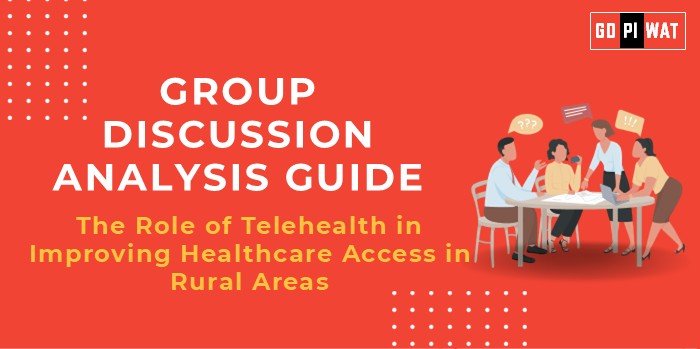📋 Group Discussion Analysis Guide
🌐 The Role of Telehealth in Improving Healthcare Access in Rural Areas
🌟 Introduction to the Topic
Opening Context:
“In the age of rapid digital transformation, telehealth has emerged as a powerful tool to bridge the gap in healthcare delivery, especially in rural areas where access to quality care remains a significant challenge.”
Background:
Telehealth, encompassing teleconsultations, remote monitoring, and digital health education, gained global prominence during the COVID-19 pandemic. In rural areas, where 70% of the population resides but only 30% of healthcare resources are available, it offers a lifeline for better health outcomes.
📊 Quick Facts and Key Statistics
- 🌍 Global Telehealth Market: Valued at $87.8 billion in 2022; expected to grow at a CAGR of 24% through 2030.
- 🇮🇳 Indian Context: Rural areas host 69% of India’s population but have only 26% of the country’s healthcare workforce (Rural Health Statistics 2022-23).
- 📈 Accessibility Impact: Teleconsultations increased by 400% in rural India during COVID-19, driven by platforms like eSanjeevani.
- 💰 Cost Efficiency: Telehealth reduces treatment costs by 30-40%, as per a WHO study.
👥 Stakeholders and Their Roles
- Government: Develops telehealth infrastructure and digital literacy programs (e.g., eSanjeevani platform).
- Private Sector: Innovates telehealth technologies and delivery mechanisms.
- Healthcare Providers: Deliver remote consultations, diagnostics, and follow-up care.
- Patients and Citizens: Adopt telehealth solutions, benefiting from affordable and timely healthcare.
- Global Organizations: WHO and ITU provide guidelines and funding support.
🎯 Achievements and Challenges
🏆 Achievements
- Over 120 million consultations through India’s eSanjeevani platform by 2024.
- Reduction in rural maternal mortality due to telehealth interventions (e.g., Tamil Nadu model).
- Increased access to specialist care, with 75% of consultations in rural regions involving urban experts.
⚠️ Challenges
- Infrastructure: Only 20% of rural households have access to reliable internet.
- Digital Literacy: Significant gaps in awareness and usage of telehealth tools.
- Regulatory Barriers: Lack of clear policies for telehealth reimbursements and cross-border consultations.
🌍 Global Comparisons
- 🇸🇪 Sweden: Telehealth system covers 98% of rural residents.
- 🇳🇬 Nigeria: Faces connectivity and trust issues in telehealth adoption.
📌 Case Study
Tamil Nadu’s Telemedicine Network: Improved maternal healthcare access by 70%, serving 12 million rural women in 2023.
📖 Structured Arguments for Discussion
- Supporting Stance: “Telehealth has democratized healthcare by enabling access to specialists for millions in underserved regions, significantly reducing travel costs and delays.”
- Opposing Stance: “Without addressing digital literacy and infrastructure gaps, telehealth’s benefits remain confined to only a fraction of rural populations.”
- Balanced Perspective: “While telehealth is a game-changer, achieving its full potential requires integrated efforts in technology, policy, and education.”
💬 Effective Discussion Approaches
Opening Approaches
- “Highlight success stories like eSanjeevani’s impact on healthcare accessibility.”
- “Use statistics to underscore telehealth’s growth and limitations.”
Counter-Argument Handling
- Challenge: Lack of trust in remote consultations.
- Rebuttal: Showcase examples of proven efficacy, like telehealth reducing diagnostic errors by 20% (Lancet, 2023).
🛠️ SWOT Analysis
- Strengths: Cost-efficiency, scalability, improved specialist access.
- Weaknesses: Digital literacy, infrastructure limitations.
- Opportunities: AI-driven diagnostics, 5G integration.
- Threats: Data security concerns, potential misdiagnoses.
🎓 Connecting with B-School Applications
Applications
- Studying telehealth models for operations management in underserved regions.
- Exploring innovative marketing for telehealth adoption in rural areas.
Sample Interview Questions
- “How can telehealth complement traditional healthcare systems in rural areas?”
- “What are the economic implications of telehealth adoption for rural populations?”


